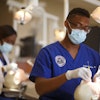Study Shows Eye Drops Can Delay, Prevent Glaucoma in Blacks
SACRAMENTO, Calif.
University of California-Davis ophthalmologists and other researchers around the country have found that pressure-lowering eye drops can delay or possibly prevent the onset of glaucoma in almost 50 percent of African Americans who are at higher risk for developing the disease.
The findings are based on a study conducted at 22 clinical centers, in which UC Davis played a prominent role both by providing the largest group of participants and serving as one of the centralized reading centers for testing in this $30 million study. The results are reported in this month’s issue of Archives of Ophthalmology.
“Our research confirmed that eye drops can play a significant role for people with elevated eye pressure by easing or even blocking the onset of glaucoma,” said Dr. James D. Brandt, professor of ophthalmology and director of glaucoma service at the UC Davis School of Medicine and Medical Center, and one of the principal investigators in the study. “The results are particularly important for the African American community because glaucoma is the leading cause of blindness, and as a group they are three times more likely than Whites to develop the disease.”
Brandt and his colleagues tested whether the daily use of pressure-lowering eye drops could affect the most common form of glaucoma — called “primary open angle” glaucoma — which is one of the nation’s leading causes of vision loss.
Their work was part of the national Ocular Hypertension Treatment Study, which found 8.4 percent of African American participants who received eye drops developed glaucoma. In comparison, 16.1 percent of the African American participants who developed glaucoma did not receive the daily eye drops.
This was the first national study to recruit large numbers of African Americans to examine the benefits of pressure-lowering eye drops. Researchers noted the study’s results help underscore the importance of having African Americans over age 40 get comprehensive dilated eye exams at least once every two years to determine glaucoma risk.
“Regular eye exams are crucial, although it does not imply that every African American with elevated eye pressure requires treatment,” cautioned Brandt. “Physicians always have to take into account a variety of risk factors, including the specific characteristics of a patient’s optic nerve and cornea. While African Americans are more likely than others to have higher glaucoma risk factors, it is critical to measure the ocular risks rather than relying solely on the race or ethnicity of an individual.”
Elevated eye pressure results when the fluid that flows in and out of the eye drains too slowly, gradually increasing pressure inside the eye. It is estimated that between three and six million people over age 40 in the United States are at increased risk for developing primary open-angle glaucoma. If detected early, glaucoma usually can be controlled and serious vision loss can be prevented.
The Ocular Hypertension Treatment Study was funded by the National Eye Institute and the National Center on Minority Health and Health Disparities, two components of the federal government’s National Institutes of Health.
— Associated Press
© Copyright 2005 by DiverseEducation.com















